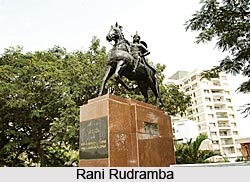 The Kakatiya dynasties where kings have exposed their power, the queen of the Kakatiya dynasty were also not lagging behind. During the12th and 13th centuries, the Kakatiyas rose to their fullest height. However, at the end of the 12th century there was a severe setback during Mahadeva`s rule. The dynasty gained back its glory under Ganapati, Rudramba and Prataparudra II.
The Kakatiya dynasties where kings have exposed their power, the queen of the Kakatiya dynasty were also not lagging behind. During the12th and 13th centuries, the Kakatiyas rose to their fullest height. However, at the end of the 12th century there was a severe setback during Mahadeva`s rule. The dynasty gained back its glory under Ganapati, Rudramba and Prataparudra II.
Ganapati had two daughters of whom the elder was Rudramba. It was Ganapati`s wish that Rudramba should succeed him on the throne. Accordingly, she assumed the masculine title of`Maharaja` and ascended the throne. She ruled from 1262 to 1296 A.D. and her reign was uniformly prosperous and peaceful.
Rudramba abdicated when her daughter`s son Prataparudra II became a major and could take over government.Thus the most prominent ruler in the Kakatiya dynasty was Rani Rudramma Devi (1262-1295/96), one of the few queens in Indian history. She was formally designated as a son through the ancient Putrika ceremony and given die male name Rudradeva. Despite initial misgivings by some of her generals who resented a female ruler, she suppressed the internal rebellions and external incursions. An able fighter and ruler Rudramba defended die kingdom from the Cholas and the Yadavas, earning their respect. She remains one of die few women defacto ruler of die Soudi in her time.
The Kakatiya era is regarded as one of the golden ages in Telugu history. The kingdom was ruled by Telugu speaking Hindu rulers who encouraged literature, art and architecture. The thousand-pillar temple in Hanmakonda stands as a testimony to this. The famous Kohinoor diamond, which was unearthed near Golconda Fort during dieir reign, was among die booty carried to Delhi after the fall of dynasty according to some modern historians.



















